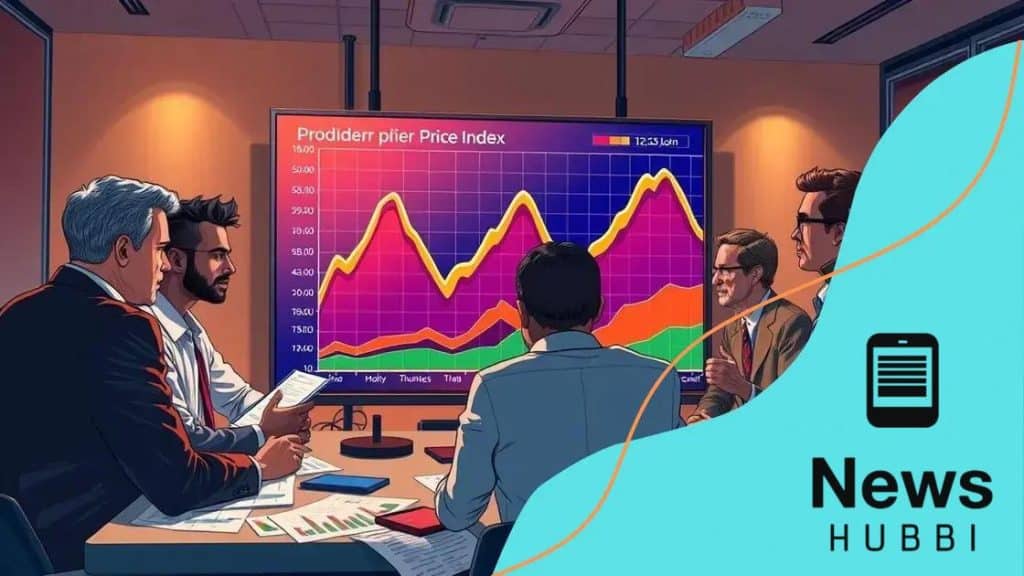Producer price index: understanding its impact on pricing

Anúncios
The producer price index (PPI) tracks the average change in prices received by domestic producers. It reflects how much businesses are earning for their goods and services.
This index is a valuable tool for understanding inflation trends. It gives early signals that can affect everything from raw materials to final product costs.
By watching PPI movements, both companies and consumers can anticipate future price shifts in the economy.
Anúncios
What is the producer price index?
The PPI helps track how much producers charge over time for their output. It serves as a window into pricing trends before they hit the consumer level.
This index reflects upstream costs that may later impact retail prices. Monitoring these changes can reveal early inflationary signals.
PPI data helps policymakers and businesses prepare for cost fluctuations. It’s also useful for understanding long-term economic patterns.
Anúncios
Understanding the Components
The PPI is made up of various segments that represent different parts of the economy. Each component offers specific insights into pricing structures.
-
Industry-specific categories: Each industry has its own PPI that tracks price changes for its products.
-
Final demand goods: This reflects the prices of goods sold directly to consumers.
-
Intermediate goods: These are products used in the production of final goods.
-
Services: The index also includes price changes for services such as transportation and utilities.
Understanding these layers helps paint a clearer picture of inflation. When production costs rise, they often trickle down to everyday prices.
The Importance of PPI
The PPI doesn’t just affect producers, it can shape consumer costs as well. When production prices increase, retail prices often follow.
A rising PPI in sectors like manufacturing could suggest higher prices ahead for consumers. This makes the index a useful early-warning system.
It also plays a role in setting interest rates and wage strategies. Central banks monitor it closely to guide economic policy decisions.
How the producer price index is calculated

The PPI is compiled by the Bureau of Labor Statistics (BLS) using a large sample of real-world prices. It represents many sectors and production stages.
The BLS collects pricing data directly from producers each month. This ensures the index reflects accurate market movements.
Each price entry is compared to a base year to measure the percentage change. Adjustments are made to reflect seasonal effects and trends.
Key Steps in Calculation
To ensure reliability, the PPI is built through a consistent multi-step process.
-
Data Collection: Prices are collected from a diverse range of industries, ensuring a comprehensive view.
-
Weight Assignment: Each product has a weight based on its importance in total production. This weight helps to plot accurate changes.
-
Index Calculation: The collected prices are compared to a base year to determine percentage changes over time.
-
Seasonal Adjustments: To provide a clearer view, seasonal fluctuations are adjusted, which helps in understanding underlying trends.
When a product like steel rises in price, it heavily influences the PPI. Its widespread use amplifies effects across multiple industries.
The role of the producer price index in inflation
The PPI plays a key role in identifying early signs of inflation. By tracking changes in production costs, it helps forecast consumer price shifts.
When businesses face higher input prices, they may increase final product prices. This process can spark broader inflation trends.
Understanding the PPI helps economists and companies stay ahead of pricing pressures. It also guides interest rate decisions and monetary responses.
How PPI Affects Inflation
The PPI helps highlight where and how inflation begins in the economy.
-
Cost Pass-Through: When producers experience an increase in input costs, they may raise the prices of finished goods to maintain profit margins.
-
Wage Pressures: If wages increase, production costs rise, prompting a potential increase in the PPI and subsequent consumer prices.
-
Sector Trends: Different sectors may show varying PPI trends, indicating which industries are facing inflation pressure. This can guide policy responses.
-
Forecasting Inflation: By analyzing the PPI, businesses and policymakers can make more informed decisions regarding pricing strategies and monetary policy.
For example, if the food PPI rises sharply, grocery prices may soon follow. That affects household budgets and daily expenses.
Impacts of the producer price index on consumers
While the PPI tracks producer-level prices, it strongly influences consumer costs. Price hikes often pass through to end buyers over time.
When raw materials get more expensive, companies adjust pricing strategies. This may cause everyday items to rise in cost for shoppers.
Consumers who follow PPI trends can better anticipate shifts in prices. It allows smarter planning and more informed purchases.
The Effects on Consumer Prices
PPI trends often shape real-world prices paid by the public.
-
Increased Retail Prices: When the cost of raw materials and production rises, retailers usually raise their prices to cover the additional costs.
-
Inflation Impact: A rising PPI can signal broader inflation trends, meaning consumers may see increasing prices in various sectors beyond just food or energy.
-
Purchasing Power: Higher consumer prices may erode purchasing power, forcing families to adjust their budgets and spending habits.
-
Consumer Confidence: When consumers notice rising prices, it can affect their confidence in the economy, impacting spending choices.
If energy costs rise in the PPI, utility bills often follow. For many households, this creates added financial pressure.
Future trends of the producer price index

The PPI is also used to forecast future economic direction. Tracking its movement reveals likely trends in pricing and inflation.
Future shifts will depend on global supply chains, labor costs, and innovation. These forces push or pull production costs.
Staying updated on PPI developments helps businesses and consumers stay prepared. It’s a roadmap to future price dynamics.
Driving Factors Behind Future PPI Trends
These key factors will shape the PPI in the coming years.
-
Technological Advancements: Innovations can improve production efficiency, potentially lowering costs and affecting the PPI.
-
Global Supply Chains: Changes in global trade policies or supply chain disruptions can impact availability and costs of inputs, influencing the PPI.
-
Consumer Preferences: A shift toward sustainable and eco-friendly products may alter production methods and prices, impacting the index.
-
Inflationary Pressures: Persistent inflation in certain sectors may lead producers to adapt pricing strategies that could significantly change the PPI.
If companies adopt automation, costs may fall, lowering the PPI. But rising material scarcity can cause upward pressure instead.
FAQ – Frequently Asked Questions about the Producer Price Index
What is the producer price index (PPI)?
The producer price index (PPI) measures the average changes in prices producers receive for their goods and services over time.
How does the PPI affect consumer prices?
When the PPI rises, it often leads to increased consumer prices as producers pass on higher production costs.
Why is the PPI important for businesses?
The PPI helps businesses forecast pricing trends and make informed decisions regarding procurement and pricing strategies.
What factors influence future trends in the PPI?
Future PPI trends are influenced by technological advancements, shifts in consumer demand, global supply chain changes, and inflationary pressures.





